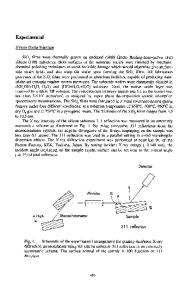Interface Properties of Pr x Al 2-x O 3 (x = 0 to 2) Dielectrics on TiN Studied by Synchrotron Radiation X-ray Photoelec
- PDF / 205,366 Bytes
- 6 Pages / 612 x 792 pts (letter) Page_size
- 25 Downloads / 332 Views
1000-L06-03
Interface Properties of PrxAl2-xO3 (x = 0 to 2) Dielectrics on TiN Studied by Synchrotron Radiation X-ray Photoelectron Spectroscopy Grzegorz Lupina, Thomas Schroeder, Christian Wenger, Jarek Dabrowski, Gunther Lippert, and Hans-Joachim Müssig Materials Research, IHP-Microelectronics, Im Technologiepark 25, Frankfurt/Oder, D-15236, Germany
ABSTRACT Extending the scalability of deep trench capacitor dynamic random access memories requires introduction of a high-k dielectric-based storage capacitor structure. Pr-enriched Al2O3 dielectrics with TiN electrodes appear as a promising materials system for this application. Electrical measurements performed on this materials combination show, however, that achieving a very low capacitance equivalent thickness and low leakage current requires very careful control of the electrode/dielectric interface properties. In particular, formation of a parasitic interface layer has to be avoided. For this purpose, we carried out a systematic synchrotron radiation x-ray photoelectron spectroscopy study to non-destructively investigate the interface reactivity of the PrxAl2-xO3 (x = 0, 1, 2) dielectrics with TiN metal electrodes. The depth profiling study shows that the TiN substrate is covered with a native TiO2. Additionally, a thin interfacial Ti oxynitride layer is present between these compounds, resulting in a TiN/TiNO/TiO2 materials stack. Molecular beam deposition of Al2O3 onto substrates of this structure leads to a remarkable reduction of the native oxide. In contrast, in the same way deposited PrAlO3 and Pr2O3 dielectrics are significantly less reactive towards TiO2. As a consequence, the native TiON/TiO2 remains the main component of the interface layer in the TiN/PrAlO3 and TiN/Pr2O3 capacitor stacks. Such a configuration poses severe scalability problems to the Pr aluminate dielectrics. INTRODUCTION Preparation of a reliable high-k dielectric-based metal-insulator-metal (MIM) storage capacitor is a necessary step to extend the scalability of the deep trench (DT) dynamic random access memories (DRAM) [1]. In this respect, Al2O3 dielectrics in combination with TiN electrodes appear to be a promising solution. This is mainly due to the high band gap of Al2O3 providing low leakage currents, and a well-developed atomic layer deposition (ALD) process for Al2O3 ensuring homogeneous coverage over the trench structures [2]. However, Al2O3 dielectrics provide only a moderate increase in the dielectric constant (k ~ 8) with respect to the traditional silicon nitride dielectrics (k ~ 6). Therefore, to make Al2O3 attractive for future highly scaled deep trench DRAMs its dielectric constant has to be improved.
To address this point we developed an engineering approach aimed at improving the dielectric constant of Al2O3 by controlled substitution of isovalent Pr3+ for Al3+ ions in Al2O3. We have shown recently that such a substitution, resulting for example in the formation of PrAlO3, provides an increase of the k-value by a factor of 3 with respect to Al2O3 [3]. However,
Data Loading...











